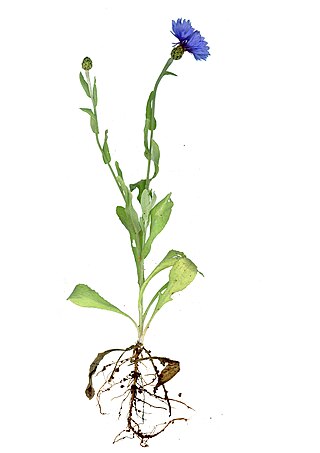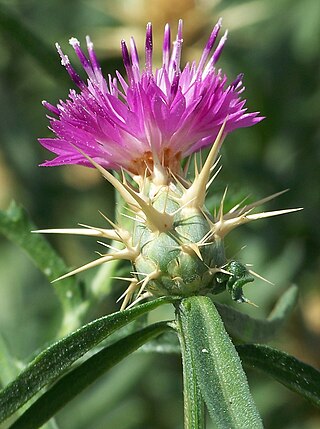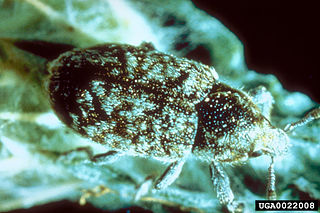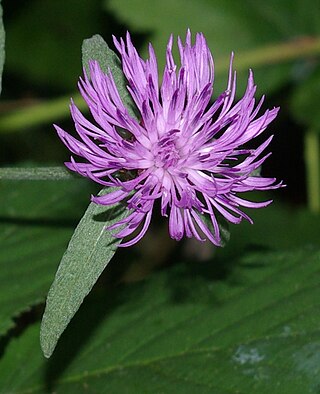
Centaurea is a genus of over 700 species of herbaceous thistle-like flowering plants in the family Asteraceae. Members of the genus are found only north of the equator, mostly in the Eastern Hemisphere; the Middle East and surrounding regions are particularly species-rich. In the western United States, yellow starthistles are an invasive species. Around the year 1850, seeds from the plant had arrived to the state of California. It is believed that those seeds came from South America.

Centaurea cyanus, commonly known as cornflower or bachelor's button, is an annual flowering plant in the family Asteraceae native to Europe. In the past, it often grew as a weed in cornfields, hence its name. It is now endangered in its native habitat by agricultural intensification, particularly by over-use of herbicides. However, Centaurea cyanus is now also naturalised in many other parts of the world, including North America and parts of Australia through introduction as an ornamental plant in gardens and as a seed contaminant in crop seeds.

Centaurea diffusa, also known as diffuse knapweed, white knapweed or tumble knapweed, is a member of the genus Centaurea in the family Asteraceae. This species is common throughout western North America but is not actually native to the North American continent, but to the eastern Mediterranean.

The Tephritidae are one of two fly families referred to as fruit flies, the other family being the Drosophilidae. The family Tephritidae does not include the biological model organisms of the genus Drosophila, which is often called the "common fruit fly". Nearly 5,000 described species of tephritid fruit fly are categorized in almost 500 genera of the Tephritidae. Description, recategorization, and genetic analyses are constantly changing the taxonomy of this family. To distinguish them from the Drosophilidae, the Tephritidae are sometimes called peacock flies, in reference to their elaborate and colorful markings. The name comes from the Greek τεφρος, tephros, meaning "ash grey". They are found in all the biogeographic realms.

Centaurea calcitrapa is a species of flowering plant known by several common names, including red star-thistle and purple star thistle. It is native to Europe but is rarely found there, it is known across the globe as an introduced species and often a noxious weed. The species name calcitrapa comes from the word caltrop, a type of weapon covered in sharp spikes.

Centaurea solstitialis, the yellow star-thistle, is a species of thorny plant in the genus Centaurea, which is part of the family Asteraceae. A winter annual, it is native to the Mediterranean Basin region and invasive in many other places. It is also known as golden starthistle, yellow cockspur and St. Barnaby's thistle.

Bangasternus fausti is a species of true weevil known as the broad-nosed seed head weevil. It is used as an agent of biological pest control against noxious knapweeds, particularly spotted knapweed, squarrose knapweed, and diffuse knapweed.
Chaetorellia acrolophi is a species of tephritid fruit fly known as the knapweed peacock fly. It is used as an agent of biological pest control against noxious knapweeds, especially spotted knapweed.

Cyphocleonus achates is a species of true weevil known as the knapweed root weevil. It is native to southern Europe and the Mediterranean and is used as an agent of biological pest control against noxious knapweeds, especially spotted knapweed. It has recently been spotted in India.
Larinus minutus is a species of true weevil known as the lesser knapweed flower weevil. It is used as an agent of biological pest control against noxious knapweeds, especially diffuse knapweed and spotted knapweed.

Larinus obtusus is a species of true weevil known as the blunt knapweed flower weevil. It is used as an agent of biological pest control against noxious knapweeds, especially spotted knapweed.

Metzneria paucipunctella is a species of moth known as the spotted knapweed seed head moth. It is used as an agent of biological pest control against noxious knapweeds, particularly spotted knapweed.

Eustenopus villosus is a species of true weevil known as the yellow starthistle hairy weevil. It is used as an agent of biological pest control against the noxious weed yellow starthistle.

Larinus curtus is a species of true weevil known as the yellow starthistle flower weevil. It is native to Southern Italy, Southern Europe, the Middle East and the Caucasuses. It is used as an agent of biological pest control against the noxious weed yellow starthistle in the United States.

Urophora affinis is a species of tephritid or fruit flies in the genus Urophora of the family Tephritidae. It has been released in the United States and Canada as a biocontrol agent to control spotted knapweed. U. affinis became established in Montana in 1973.

Puccinia jaceae var. solstitialis is a species of fungus in the Pucciniaceae family. It is a plant pathogen that causes rust. Native to Eurasia, it is the first fungal pathogen approved in the United States as a biological control agent to curb the growth of the invasive weed yellow starthistle.
Larinus filiformis is a species of true weevil found in Armenia, Azerbaijan, Turkey, and Bulgaria.
Chaetorellia succinea is a species of tephritid fruit fly that was accidentally released in 1991 into the United States and had since become one of the major biological pest controls against the noxious weed yellow starthistle.

Meadow knapweed, also known as hybrid knapweed or protean knapweed, is a fertile hybrid between black knapweed and brown knapweed. The taxonomic status of the species is uncertain, and meadow knapweed has been variously described as different species.














